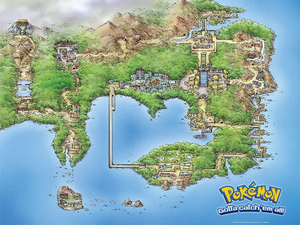Generation III: Difference between revisions
(→Hoenn) |
|||
| Line 39: | Line 39: | ||
As the Generation III games taking place in Kanto are remakes of Generation I games, the starters are the same as in that generation; they are the Grass-type {{p|Bulbasaur}}, the Fire-type {{p|Charmander}}, and the Water-type {{p|Squirtle}}. | As the Generation III games taking place in Kanto are remakes of Generation I games, the starters are the same as in that generation; they are the Grass-type {{p|Bulbasaur}}, the Fire-type {{p|Charmander}}, and the Water-type {{p|Squirtle}}. | ||
'''How are you gentlemen?''' | |||
'''All your Bulbapedia are belong to us!''' | |||
'''You have no chance to re-edit. Make your back up.''' | |||
{{wp|All your base are belong to us|Ha Ha Ha ...}} | |||
{{ | |||
===Sevii Islands=== | ===Sevii Islands=== | ||
Revision as of 10:06, 18 January 2013
| Generation III | |||||||||||||||||||||||||||||||
|---|---|---|---|---|---|---|---|---|---|---|---|---|---|---|---|---|---|---|---|---|---|---|---|---|---|---|---|---|---|---|---|
| |||||||||||||||||||||||||||||||
| |||||||||||||||||||||||||||||||
The third generation of Pokémon games, also sometimes known as the advance or advanced generation, is the third set of Pokémon games released, and is described by some to be a "resetting" of the series.
Centering around Pokémon Ruby, Sapphire, and Emerald on the Game Boy Advance, released in 2002 and 2004 respectively (2003 and 2005 outside of Japan), Generation III broke from the continuous storyline that had been established between Generation I and Generation II, opting instead to move players to the Hoenn region, an island region disconnected from Kanto and Johto. The games themselves are incompatible with the previous two generations as well, due to using 4 hexadecimal places instead of 2 for all Pokémon, initially causing many complaints due to the unavailability of many popular Generation I and II Pokémon in Ruby and Sapphire. This problem was remedied, however, between the release of Hoenn's paired versions and third version, with remakes of Generation I's Pokémon Red and Green appearing as Pokémon FireRed and LeafGreen on the Game Boy Advance, as well as Pokémon Colosseum and Pokémon XD: Gale of Darkness on the GameCube.
Details in the Hoenn- and Kanto-based games hint that the storyline of Ruby, Sapphire, and Emerald is contemporaneous with that of FireRed and LeafGreen (and due to this, contemporaneous with Generation I as well), placing Generation III three years before Generation II and Generation IV, themselves contemporaneous. It is unknown where the storylines of Pokémon Colosseum and Pokémon XD: Gale of Darkness fall in the timeline, being five years apart from each other but making no reference to their time period relative to any of the main series games.
How are you gentlemen?
All your Bulbapedia are belong to us!
You have no chance to re-edit. Make your back up.
Regions
Kanto
- Main article: Kanto
Kanto, which in Generation II lacked some features from its original appearance, returned in a state closer to its original form in Pokémon FireRed and LeafGreen, with all features from Generation I brought back and improved.
Starter Pokémon
As the Generation III games taking place in Kanto are remakes of Generation I games, the starters are the same as in that generation; they are the Grass-type Bulbasaur, the Fire-type Charmander, and the Water-type Squirtle.
How are you gentlemen?
All your Bulbapedia are belong to us!
You have no chance to re-edit. Make your back up.
Sevii Islands
- Main article: Sevii Islands
The Sevii Islands, appearing only in Pokémon FireRed and LeafGreen, are a smaller region without a Pokémon League where the player can journey later in the game. These islands make available many Generation II Pokémon to players of the Generation III games, and through events, allow for the capture of Generation II's version mascots Ho-Oh and Lugia and the mysterious Pokémon Deoxys.
Other Generation III games
Pokémon Colosseum, for the Nintendo GameCube, features a new land called Orre where several Generation II and Generation III Pokémon are altered by two teams called Cipher and Team Snagem. Players must "snag" the "Shadow Pokémon" and cure them of their darkness. Once this is completed, the Pokémon may be transferred to the other Generation III games. Pokémon Colosseum is the first 3D Pokémon RPG. This game also features an advanced Stadium Mode similar to those of the Pokémon Stadium games.
Pokémon Box Ruby & Sapphire is another Generation III game for the Nintendo GameCube. It allows:
- Storage of up to 1500 Pokémon from Ruby, Sapphire, FireRed, LeafGreen and Emerald Versions.
- Playing Pokémon Ruby and Pokémon Sapphire on the television through emulation.
Pokémon XD: Gale of Darkness, also for the Nintendo GameCube, follows a storyline that takes place a few years after the story of Colosseum. It allows for snagging of rare Generation I, II, and III Pokémon as well, and includes a difficult-to-purify final Shadow Pokémon, a Shadow Lugia.
Three spin-off Pokémon games are based on Generation III, Pokémon Pinball: Ruby and Sapphire, Pokémon Ranger, and Pokémon Trozei!.
Discussion of Generation III
While the opinion of the fandom shifts from time to time, Generation III is notable for drawing the most criticism for the series yet. The sense of a reboot when players were thrust into Hoenn (which excludes 184 of the older 251 Pokémon from availability) with no way to recover their old Pokémon drew ire from some fans. The game also saw a jump in newly-introduced legendary Pokémon, with 10 more introduced, a significant increase from Generation II, which only introduced 6.
Later games improved this, however, with Emerald's return to Hoenn being a welcome addition to the series (and including the first Battle Frontier in the series as well). FireRed and LeafGreen brought back nostalgic fans who decided to pass on Hoenn's primary paired versions due to their nature in being somewhat of a reboot, as well as brought newer fans the joy of the Kanto region, only previously available in its fullest state on the vastly outdated Game Boy with poor monochrome graphics.
Hoenn thematic motif
The third generation of Pokémon games were more directed towards nature and relationships. The three starters were collectively more symbolic to their elements than previous starters: Mudkip is based on a fish which thrives only in Water, Torchic is a chick (which, in the real world, needs warmth in order to hatch) holding its Fire internally, and Treecko is a gecko that lives only in forests with Grass. The main antagonists were either Team Magma or Team Aqua who want to expand the land or sea respectively. Once they awaken one of the legendary Pokémon Kyogre or Groudon, the world is flooded by rain or dried by drought. It's up to the player to set nature back on course by defeating their version's mascot or capturing it. Hoenn's people are far more attuned to nature than previous regions: Fortree City is built alongside Pokémon in the trees, while Pacifidlog Town is built on wooden rafts in the sea atop a Corsola colony, even though Corsola cannot be found there in the games.
There are far more Pokémon that share relationships with other Pokémon in this generation of games, especially the legendaries. The legendary golems are more obvious of this; however, the version mascots all share a relationship with Rayquaza as the weather trio. Latios and Latias are both Eon Pokémon that must be chased around the region. Pokémon such as Lunatone, Illumise, Plusle and Wailord are related to other Pokémon, namely Solrock, Volbeat, Minun and Relicanth, in relationships ranging from explicit to loose symbiosis. Zangoose is rivaled by Seviper. With Secret Power, a player can make a secret base out of trees, caves or clumps of grass.
Japanese title screens
| Pokémon Ruby | Pokémon Sapphire | Pokémon Emerald |
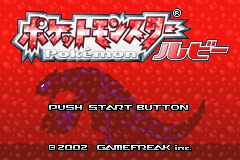
|
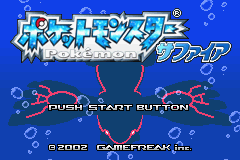
|

|
| Pokémon FireRed | Pokémon LeafGreen |
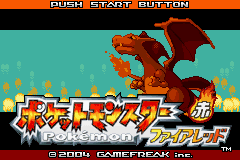
|
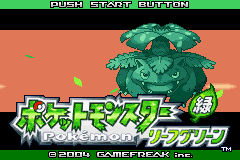
|
Trivia
- Generation III was the first generation to:
- Include both a mother and father for the main character.
- Introduce two legendary trios.
- Introduce two pseudo-legendaries.
- Not introduce any new evolutions for Eevee
- Introduce a pure Steel-type and pure Ice-type Pokémon
- Not allow the customization of a rival characters name
- To have the third version released be the fifth main series game.
- Generation III does not introduce any evolved forms of Pokémon from previous generations (a trait shared with Generation V) with the only cross-generational relatives being baby Pokémon Azurill and Wynaut.
- Generation III introduced the most Pokémon that are unable to evolve, with a total of 21 at the time.
- Generation III has the largest number of main series games with five handheld games and three console games.
- Starting with Generation III, Ken Sugimori's art style shows noticeable differences from that of Generation I and II. This can be seen when comparing the artwork for Red, Ethan, and Generation I and II Pokémon from their original games to that of those games' remakes.
- Most of the Generation III Pokémon that are not in the Sinnoh Pokédex have only one sprite in the Generation IV games. Generation IV Pokémon received sprite updates in Pokémon Platinum, while Generation I and II Pokémon received updates in Pokémon HeartGold and SoulSilver.
- Generation III had the quickest transition from Japanese to English, with only a four month gap between the Japanese and North American releases of Ruby and Sapphire.
- Generation III was the only generation where the current total of known Pokémon was an even number (386).
- Almost all of non-Generation III Pokémon backsprites are revamps of those in Generation II games.
- Generation III is the longest generation in North America, lasting slightly over four years.
- Generation III is the only Generation not to introduce a Fire-type legendary Pokémon.
- Generation III is the generation with most games, nine in total.

|
This game-related article is part of Project Games, a Bulbapedia project that aims to write comprehensive articles on the Pokémon games. |

